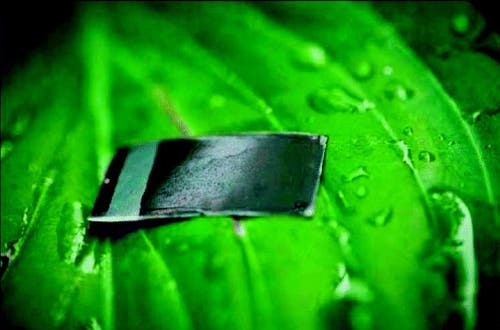Using only energy from the sun, a pioneering artificial leaf system splits water to generate hydrogen – a highly energy dense fuel. When Daniel Nocera, then a professor at MIT, announced his device for the first time four years ago, people were really hyped about it but it soon became clear that making hydrogen was only part of the solution. “The problem with the artificial leaf,” Nocera says, is that “it makes hydrogen. You guys don’t have an infrastructure to use hydrogen.” Why aren’t we seeing more hydrogen cars on the streets? Because there aren’t any hydrogen fueling stations. Why aren’t any hydrogen pumps? Because hydrogen is one bad mother. It’s the smallest stable molecule and it naturally wants to escape into the atmosphere. To contain it you need to compress it to at least 10,000 PSI (more like 100,000 PSI to be sure) which makes it extremely expensive and prohibitive.
Sunlight to liquid fuel

The prototype for the first practical “artificial leaf,” which has been hyped in the media since its flashy debut at the American Chemical Society national meeting last year. Image: MIT
Conspiracies aside, diesel and gasoline are here to stay for a long while because they’re so convenient – they’re cheap, readily available and liquid at normal temperature and pressure. Also, while hydrogen has more energy per unit mass than other fuels, it’s much less dense than other fuels. A gallon of gasoline has a mass of 6.0 pounds, the same gallon of liquid hydrogen only has a mass of 0.567 pounds or only 9.45% of the mass of gasoline. Therefore one gallon of gasoline yields 125,400 BTUs of energy while a gallon of liquid hydrogen yields only 34,643 BTUs or 27.6% of the energy in a gallon of gasoline. What are we to do with an artificial leaf that makes hydrogen, then? Well, Nocera and his new colleagues at Harvard now report pairing their hydrogen-generating leaf with an engineered bacteria called Ralstonia eutropha to generate biomass and isopropyl alcohol, respectively – an alcohol fuel comparable to ethanol. This way, the extra step converts the hydrogen in a much more manageable fuel. Though, far from efficient right now, the system might become a viable means of storing energy from the sun – still a lifelong engineering problem.
Biofuels like ethanol are made from biomass. We call biomass any biological material derived from living, or recently living organisms – most often than not plants. In nature, plants use photosynthesis to capture CO2 and use it with water in the presence of energy from the sun to make organic compounds of carbons. These are stored and can then be used to generate energy. Sticking with ethanol, this can be broken down from starchy corn kernels. The Harvard system bypasses the biomass step and goes straight to liquid fuel thanks to their engineered bacterium.
The simple setup consists of a triple-junction solar cell, connected with two catalysts: cobalt-borate for splitting the water molecule and a nickel-molybdenum-zinc alloy to form the hydrogen gas. The bacteria then absorbs the hydrogen, combines it with carbon dioxide, eventually producing the isopropyl alcohol. The resulting system would look like an algae farm, Nocera says, except that the bacteria wouldn’t need the continuous light or maintenance that algae require.
While it all sounds extremely appealing, there are still many challenges that the researchers need to overcome. One has already been met. In initial runs the bacteria kept dying. They eventually identified reactive oxygen as being the culprit, but what was surprising was its source. Reactive oxygen species were coming out of the hydrogen side of the water splitting, not the oxygen side. “We were shocked,” Nocera said for National Geographic. “That confused us for a while.”
Next, they need to improve the system’s flow such that it might become efficient and make sense economically. Right now, there’s more energy going into growing the microbes and extracting the fuel than going out. Findings appeared in PNAS.









